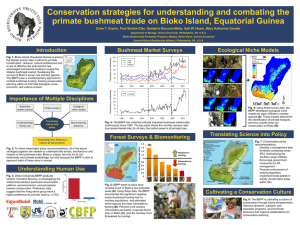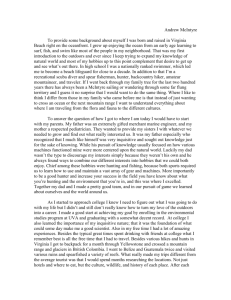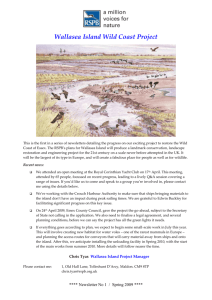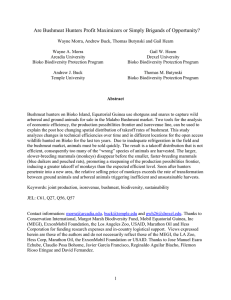BB biokotravel - mammal watching around the world
advertisement
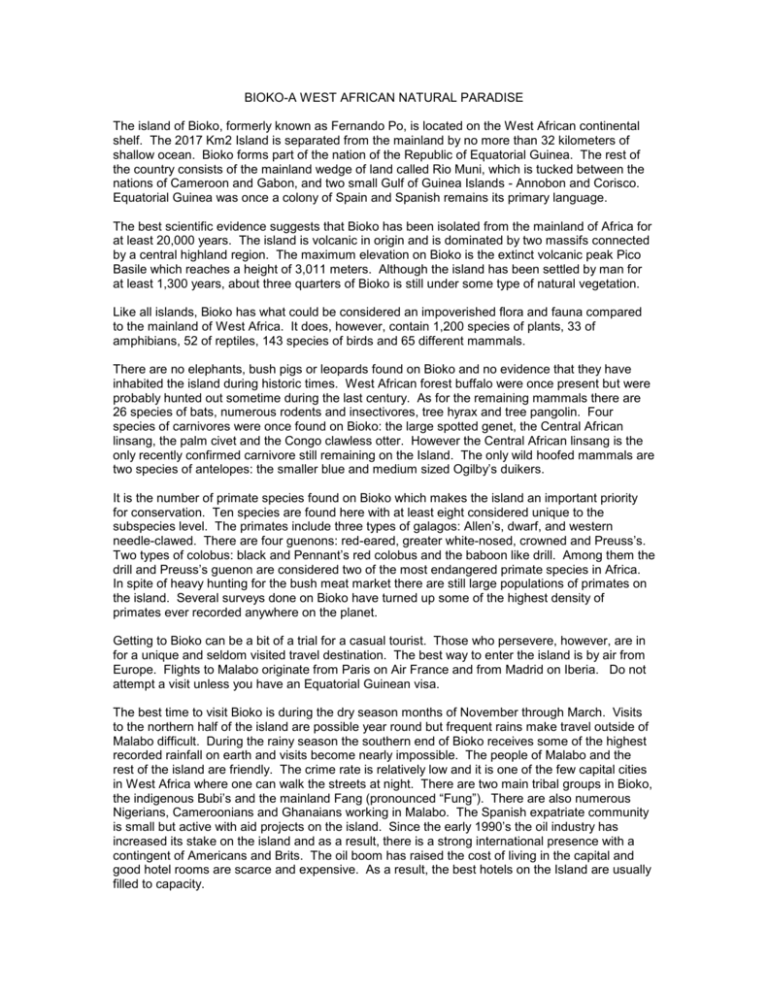
BIOKO-A WEST AFRICAN NATURAL PARADISE The island of Bioko, formerly known as Fernando Po, is located on the West African continental shelf. The 2017 Km2 Island is separated from the mainland by no more than 32 kilometers of shallow ocean. Bioko forms part of the nation of the Republic of Equatorial Guinea. The rest of the country consists of the mainland wedge of land called Rio Muni, which is tucked between the nations of Cameroon and Gabon, and two small Gulf of Guinea Islands - Annobon and Corisco. Equatorial Guinea was once a colony of Spain and Spanish remains its primary language. The best scientific evidence suggests that Bioko has been isolated from the mainland of Africa for at least 20,000 years. The island is volcanic in origin and is dominated by two massifs connected by a central highland region. The maximum elevation on Bioko is the extinct volcanic peak Pico Basile which reaches a height of 3,011 meters. Although the island has been settled by man for at least 1,300 years, about three quarters of Bioko is still under some type of natural vegetation. Like all islands, Bioko has what could be considered an impoverished flora and fauna compared to the mainland of West Africa. It does, however, contain 1,200 species of plants, 33 of amphibians, 52 of reptiles, 143 species of birds and 65 different mammals. There are no elephants, bush pigs or leopards found on Bioko and no evidence that they have inhabited the island during historic times. West African forest buffalo were once present but were probably hunted out sometime during the last century. As for the remaining mammals there are 26 species of bats, numerous rodents and insectivores, tree hyrax and tree pangolin. Four species of carnivores were once found on Bioko: the large spotted genet, the Central African linsang, the palm civet and the Congo clawless otter. However the Central African linsang is the only recently confirmed carnivore still remaining on the Island. The only wild hoofed mammals are two species of antelopes: the smaller blue and medium sized Ogilby’s duikers. It is the number of primate species found on Bioko which makes the island an important priority for conservation. Ten species are found here with at least eight considered unique to the subspecies level. The primates include three types of galagos: Allen’s, dwarf, and western needle-clawed. There are four guenons: red-eared, greater white-nosed, crowned and Preuss’s. Two types of colobus: black and Pennant’s red colobus and the baboon like drill. Among them the drill and Preuss’s guenon are considered two of the most endangered primate species in Africa. In spite of heavy hunting for the bush meat market there are still large populations of primates on the island. Several surveys done on Bioko have turned up some of the highest density of primates ever recorded anywhere on the planet. Getting to Bioko can be a bit of a trial for a casual tourist. Those who persevere, however, are in for a unique and seldom visited travel destination. The best way to enter the island is by air from Europe. Flights to Malabo originate from Paris on Air France and from Madrid on Iberia. Do not attempt a visit unless you have an Equatorial Guinean visa. The best time to visit Bioko is during the dry season months of November through March. Visits to the northern half of the island are possible year round but frequent rains make travel outside of Malabo difficult. During the rainy season the southern end of Bioko receives some of the highest recorded rainfall on earth and visits become nearly impossible. The people of Malabo and the rest of the island are friendly. The crime rate is relatively low and it is one of the few capital cities in West Africa where one can walk the streets at night. There are two main tribal groups in Bioko, the indigenous Bubi’s and the mainland Fang (pronounced “Fung”). There are also numerous Nigerians, Cameroonians and Ghanaians working in Malabo. The Spanish expatriate community is small but active with aid projects on the island. Since the early 1990’s the oil industry has increased its stake on the island and as a result, there is a strong international presence with a contingent of Americans and Brits. The oil boom has raised the cost of living in the capital and good hotel rooms are scarce and expensive. As a result, the best hotels on the Island are usually filled to capacity. The largest town, Malabo, is a picturesque collection of Spanish colonial buildings, open plazas with a gothic style cathedral, Santa Isabel. Malabo reminds many of a Caribbean capital with its old Spanish architecture and scenic harbor with the aforementioned cloud-capped Pico Basile forming an impressive backdrop. Most of the birds found in Malabo are common species,frequently encountered in African cities, such as black kite, village weaver and the pied crow. However, red-eyed doves, black-necked weaver, grey-crowned negro finch and bronze mannikin are commonly found within the city. Malabo has a little known nocturnal attraction. The area around the old port has a small roast of the large and impressive hammer-headed bats. Tours of the imposing Pico Basile should be arranged in Malabo since permits are needed. The top of the Pico can be a cold, windy place. However, the mist-shrouded high altitude Afro alpine vegetation is worth seeing. A keen eyed visitor may even spot one of the two species of birds unique to Bioko, the Fernando Po speirops. Also present are great blue turaco, mountain sawwing, Fernando Po olive-back and Ursula’s sunbird. Due to Pico Basile proximity to Malabo monkeys have been almost hunted out of the area although it is still possible to see Preuss’s guenon at the summit and red-eared guenon on the way up. The only way to visit the mountain is to drive up to the top and return to Malabo, the same day. The road up the slope is in poor condition so expect to commit to a long days excursion. Getting around the island can be expensive, although sharing the cost of a vehicle can substantially lower the cost. Bush taxis travel throughout the island’s limited road network. From Malabo a two-lane highway connects through the east coast towns of Baney and Riaba, passing through lush coca and banana plantations and small sleepy villages en route. The road eventually turns west to Luba and then back north to Malabo. Luba is a small, somewhat rundown town in a picturesque setting surrounded by hills covered by secondary forest and coca palms, fronted by a wide bay. During the Cold War years Equatorial Guinea had strong ties to the Soviet Union and it is rumored that Russian submarines would occasionally take on supplies here. Luba has the best beaches on the island, one of which is made of white sand. Most beaches on Bioko are black sand and they, along with the presence of Pico Basile and the remains of other dormant peaks, are another remnant of Bioko’s volcanic origins. Southeast of Luba are the Moca highlands. They reach a height of 2,000 meters and the resultant Afro alpine vegetation and cooler air give it a radically different feel from not only the rest of Bioko but also the rest of West Africa. The area has been called the African equivalent of the Swiss Alps without the snow. There are several forest covered mountains, two volcanic crater lakes and a 200 meter high waterfall within hiking distance from Moca town. Wildlife species which may be encountered include the black colobus and red-eared guenon, tree hyrax, great blue and Verraux’s turacos, bar-tailed trogon, palm nut vulture and rock python. There is also a Wildlife Research Center here that is operated by the Bioko Biodiversity Fund. Moca can be reached by car from Luba and basic lodgings can be found here. For the committed naturalist the southern part of the island holds its best attractions. This area of Bioko is the most pristine and is uninhabited except for the village of Ureca. The easiest access to this region of the island is by boat, though a fit person can hike to Ureca from Moca. Ureca has a population of less than 200 people and is an excellent location for wildlife viewing since it is surrounded by oil palm plantations, secondary and primary forest. Black-wattled hornbills, colorful sunbirds, flocks of grey parrots, palm nut vultures, straw-colored and Angolan fruit bats, 5 species of squirrels – pygmy, red-cheeked rope, green, red-legged and African giant and troops of redeared and crowned guenons are common sights. Even the endangered drills are sometimes encountered in the vicinity. In season, leatherbacks, the largest of Bioko’s sea turtles, nest on the village beaches. There is a small guesthouse at Moraka beach, a few hours walk west of Ureca. Primates and duikers are numerous in the forest which lines the black sand beaches on the south side of the Island. Both types of duikers, both of the colobus monkeys and three of the four species of guenon are often sighted. Drills are seen with less frequency but this area remains of the best places in all of Africa to see them in the wild. At dusk large flocks of straw-colored fruit bats fly overhead. Using a torch while walking in the forest at night can reveal Gabon vipers, forest cobras, galagos, giant rats and other species. A determined birder can hike west of Moraka beach to the Rio Ole and follow the boulder-strewn river until they reach the cliffs at the upper end of the stream. It is here that one would have the chance to see one of the rarest birds in Africa, the grey-necked picathartes. During the months of November through February four types of sea turtles - the green, leatherback, hawksbill and olive ridley nest on Moraka’s black sand beaches. There once was a heavy harvest here of both nesting females and their eggs by the residents of Ureca. Bioko Biodiversity Fund has set up a project which pays the villagers to protect the turtles and collect scientific information on them. The Grand Caldera Volcanica de Luba is Bioko’s biological crown jewel. It is a remote hollowed out volcanic crater sheltering wildlife from hunting or other human influences. It contains the largest populations of diurnal primates remaining on the Island. The Calderas wildlife has been featured in National Geographic Magazine and a documentary – Creatures of the Caldera. The Caldera is only accessible by scientific expedition. The Bioko Biodiversity Fund accepts adult volunteers on its annual census of the Gran Caldera primates. Their contact details are below. Bioko Biodiversity Fund Department of Bioscience and Biotechnology Drexel University 3200 Chestnut Street Philadelphia, Pa 19104 - USA For travel information contact the Bioko Biodiversity Fund on their web site – www.bioko.org
